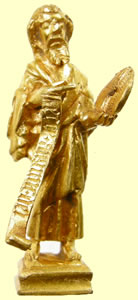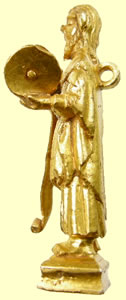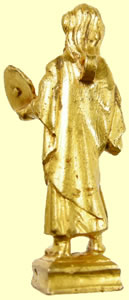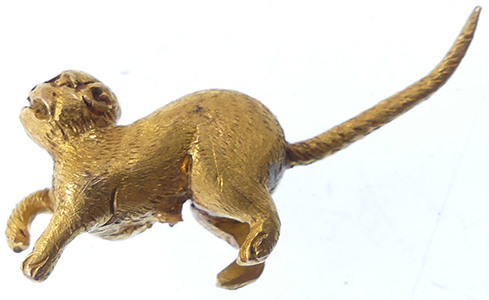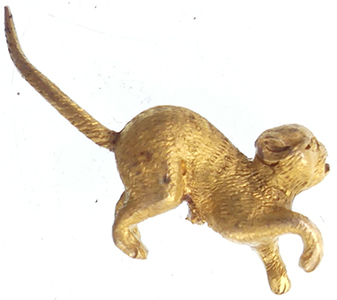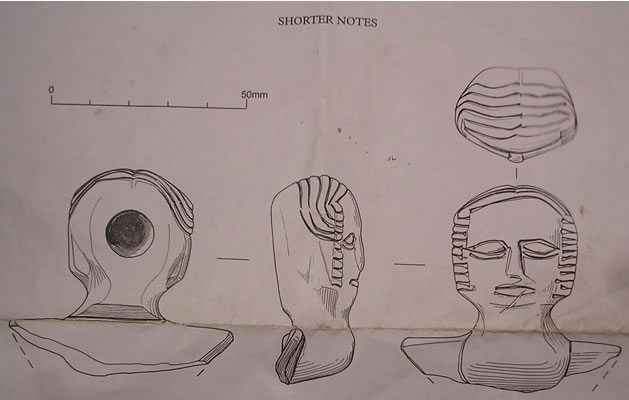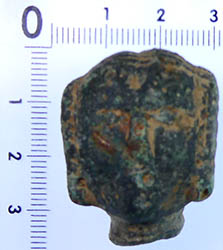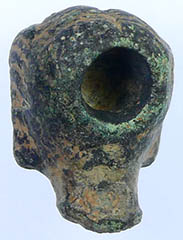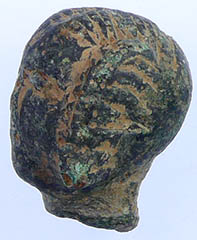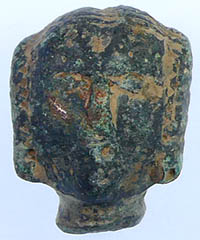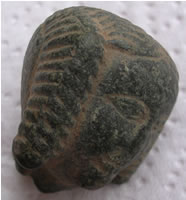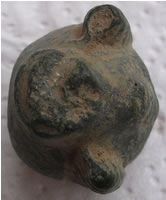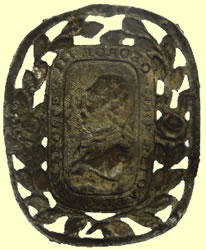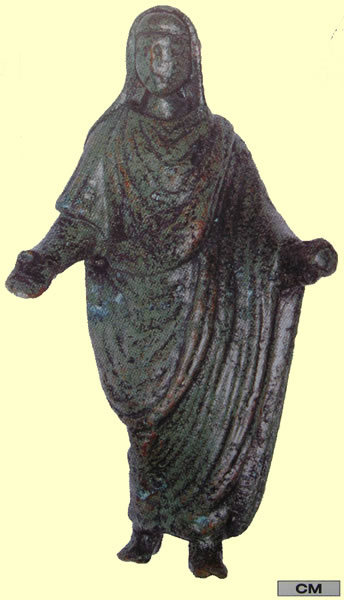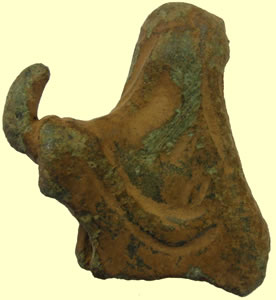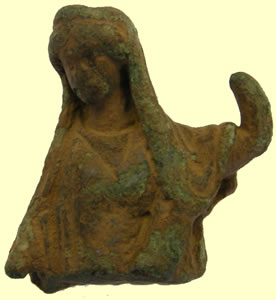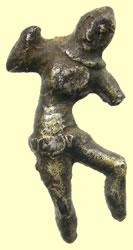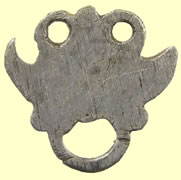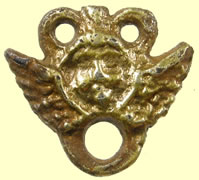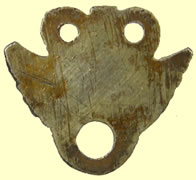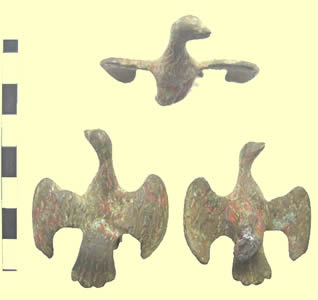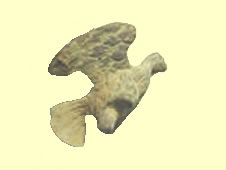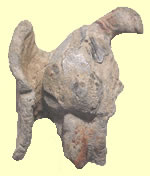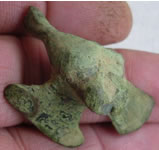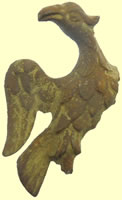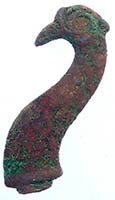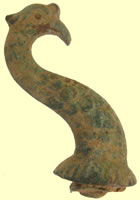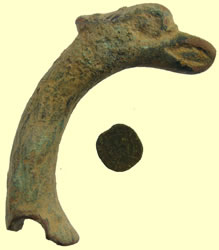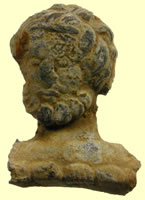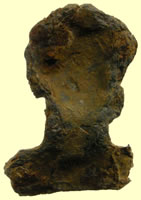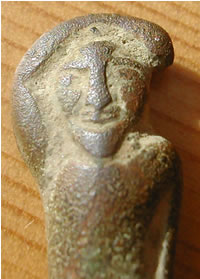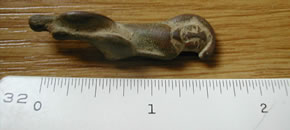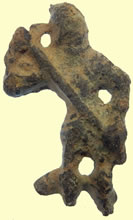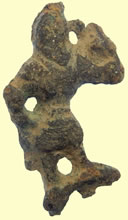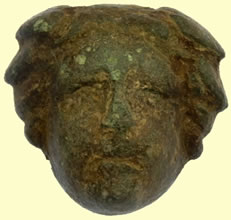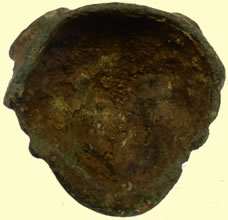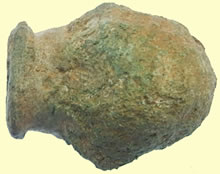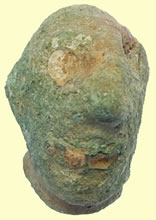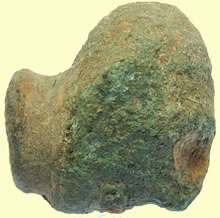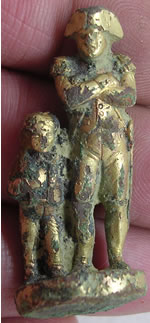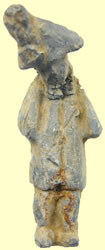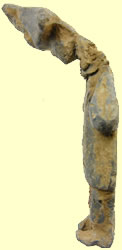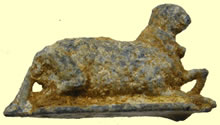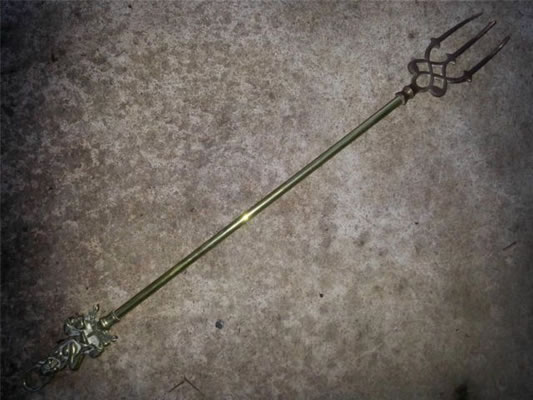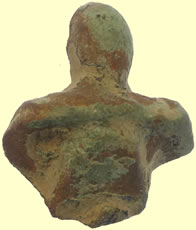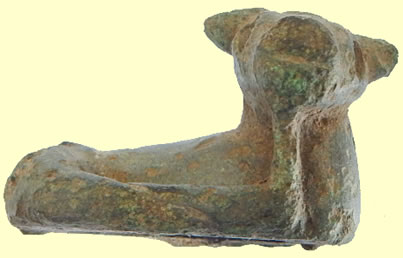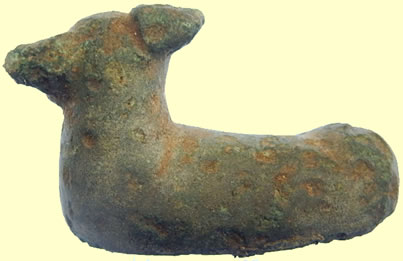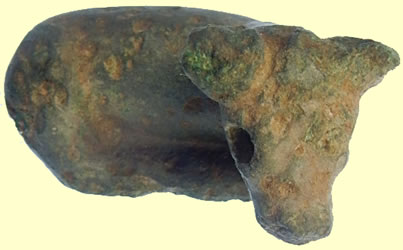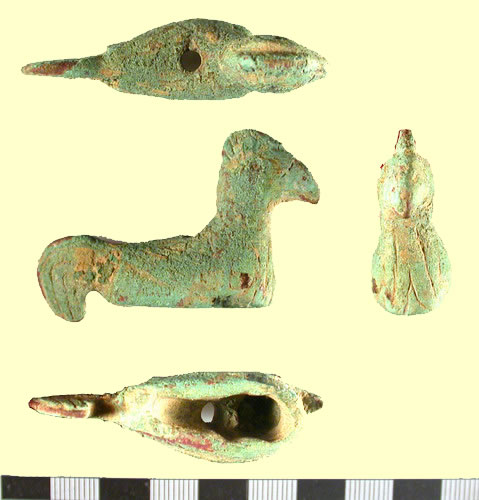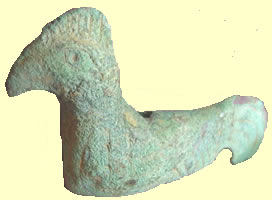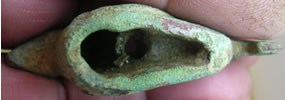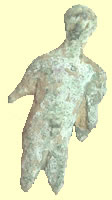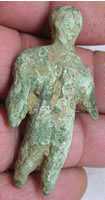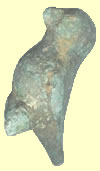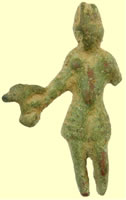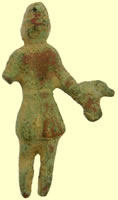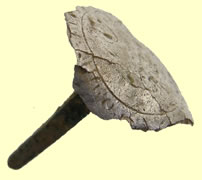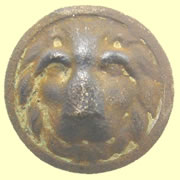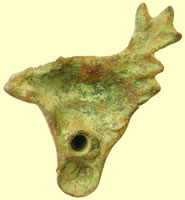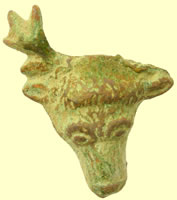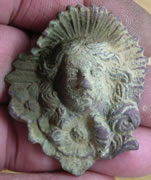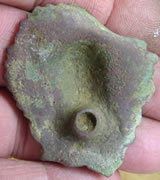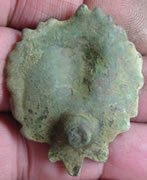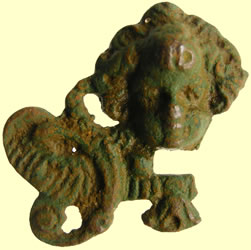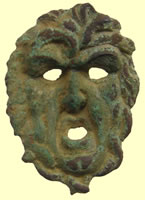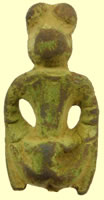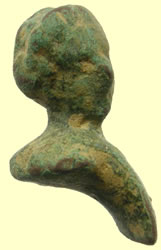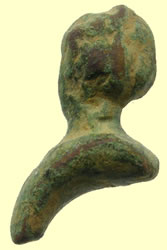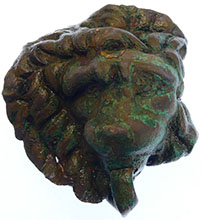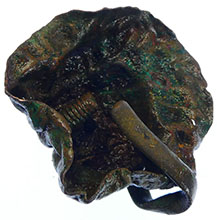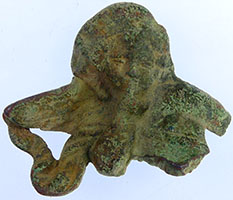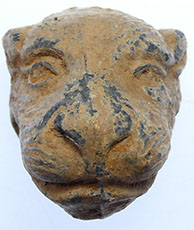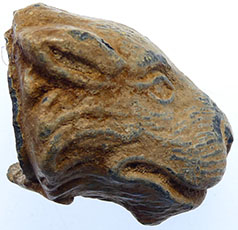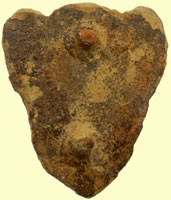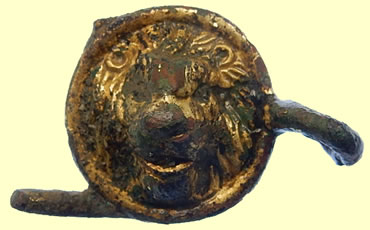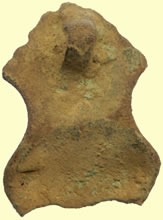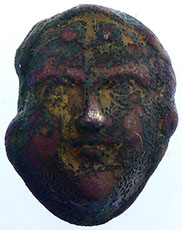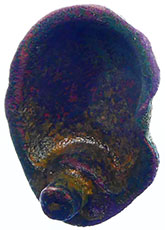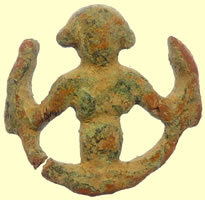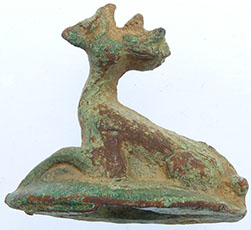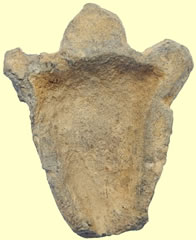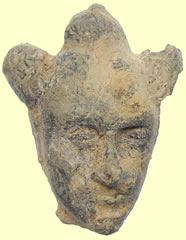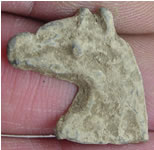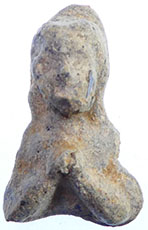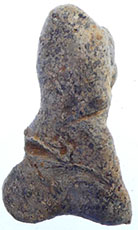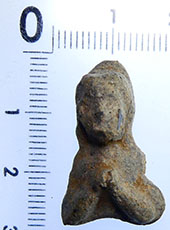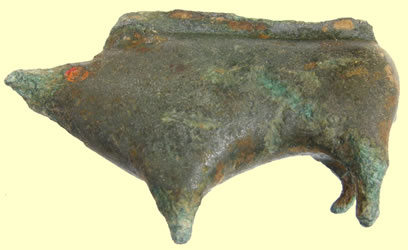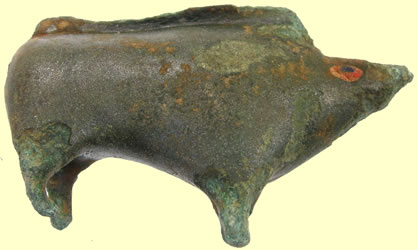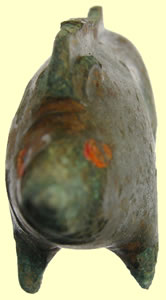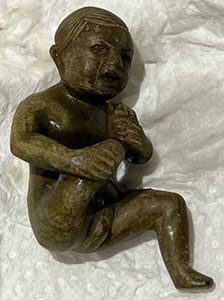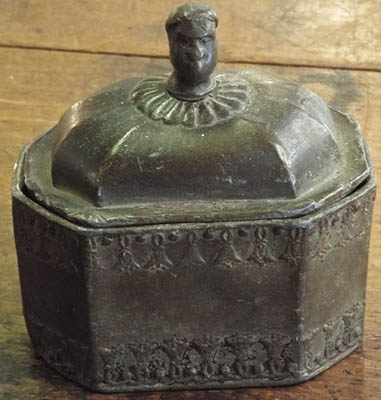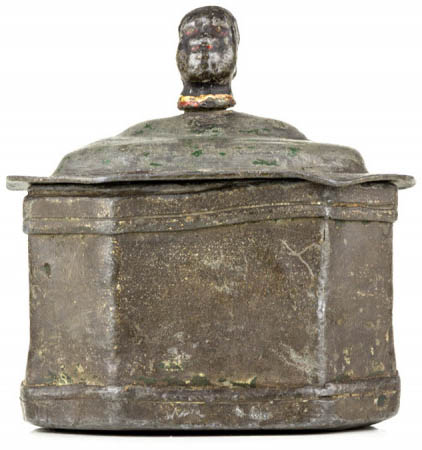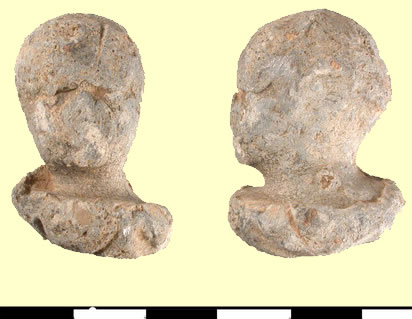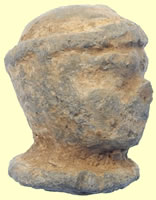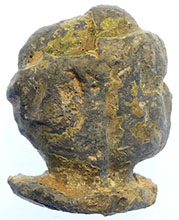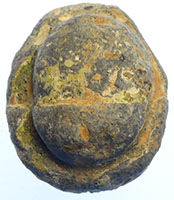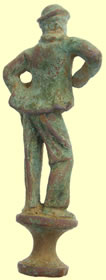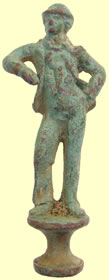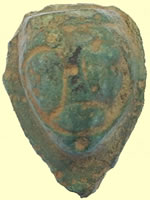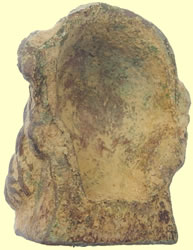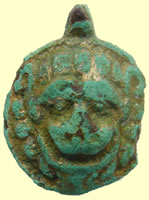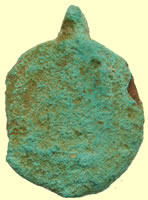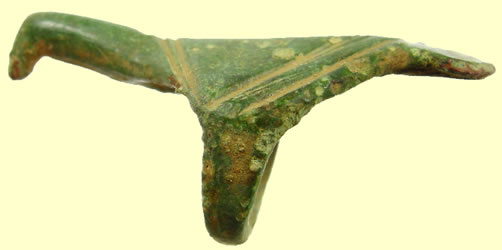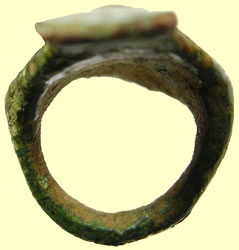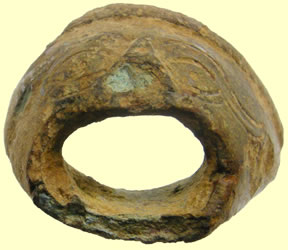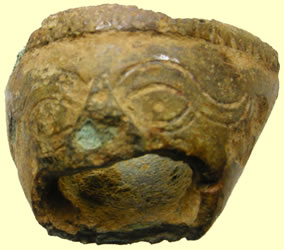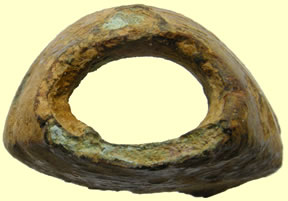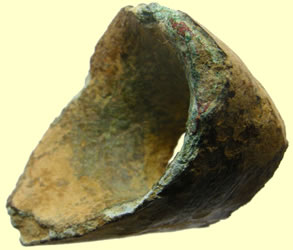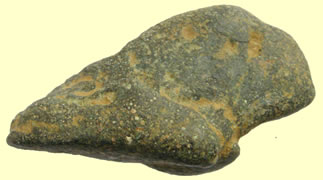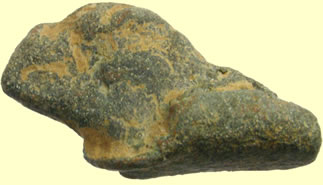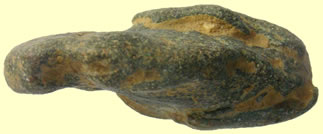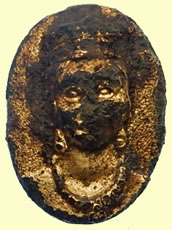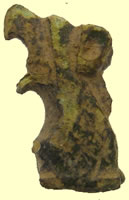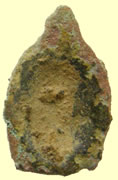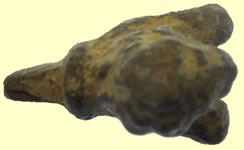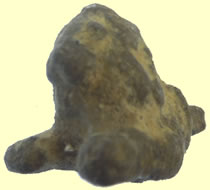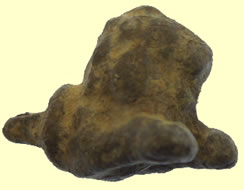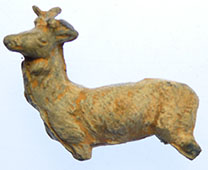

Metal detecting holidays in England with the World's most successful metal detecting club.20 years plus.
Twinned with Midwest Historical Research Society USA.
Head,animal and figurine mounts |
Stunning medieval gold statue pendant - C15thC
Treasure Report: 2008 T581 A medieval figure of John the Baptist. The saint is shown not in his usual attribute of a camel skin, but in the robes of a prophet. He gestures with his right hand to a salver, which he holds in his left. This was originally designed to carry a lamb, signifying the Lamb of God. A scroll issues from the Saint’s left hand and is inscribed with the words The figure stands on a small plinth with a finished base. It is designed to be seen in the round and on its back there is a loop for attachment to an object. It would probably have been entirely enamelled, but no traces of enamel survive on the figure. The figure is gold and dates from the late fifteenth or early sixteenth century. Dimensions: height 33 mm, width 11 mm, depth 10 mm.
Consequently, in terms of age and as the object contains a minimum of 10% precious metal it qualifies as Treasure under the stipulations of the Treasure Act 1996.
Medieval monkey picture
Stunning detailed high carat gold animal figurine - reported to museum as potential treasure This was on a site with 1300 BC items found, Roman and Celtic gold finds so impossible to date - I will go for medieval 3.0g, 24.4 mm L x 3.9mm W
|
| A deep circular hollow in the back of the head is for the attachment of a handle and the break at the neck is where the head would have been soldered to the side of the vessel The mount represents the laver's greatest point of weakness and thus its most vulnerable point of weakness. A complete laver with female head mounts is in the collections of the British Museum (Cat No MME 1956, 7-2,1) ' |
Medieval bronze bucket handle mount 84.33g, 28.39mm W,32.16 L x 23.84mm T
|
| Medieval bronze vessel handle mount |
Stunning 18thC George III silver mount GEORGE III BELOVED OF HIS PEOPLE
Roman veiled standing togate figure - popular throughout the Roman Empire but quit a rare find in Britain 50mm high The small size of the statue, the thin profile of the head and upper body, and the somewhat Augustan or Julio-Claudian traits reflected in the face all indicate that the statue was made, probably as a public or personal votive offering, in a central Italian workshop, such as that which produced the large votive bronzes from Nemi.
Treasure Report: 2009/T218 A small Medieval figure of a knight, missing his arms and the bottom part of his legs. The sinuous pose suggests that the figure is meant to represent St George spearing the dragon. The dragon ought to have been positioned beneath his feet, but this part of the composition is missing. In this respect and in terms of its dimensions, the figure resembles mass produced pilgrim souvenirs generated by the cult of St George at Windsor Castle. What distinguishes this figure is that it is cast in the round unlike pilgrim badges of the same period. On the reverse are the remains of a loop, used either for stitching on to a garment (most likely) or for suspension. The figure is silver and dates from the fifteenth century. Dimensions: length 18 mm, width 9 mm.
|
16thC Tudor gold on silver cherub mount (left) - reported as treasure. Interesting to compare a similar example (right) we found in the first half of the season curently going through the treasure process. |
A copper alloy Roman votive bird figurine (1st-2nd century AD). The figurine depicts a bird with outstretched winds and neck curved so the head faces one side. The tail is fan-shaped with a scalloped edge representing the ends of feathers. The neck and body are decorated with s-shaped incised lines; the wings and tail are decorated with thicker and more irregular lines all representing the feathers. This decoration is on both the upper and lower surfaces. There is a broken stump where the feet would have been, this is probably where the figurine was attached to another object. The figurine is probably representing a phoenix or an eagle. It is more likely a phoenix due to the long slender neck and short pointed beak (an eagle's beak would be more curved). Notes: Figurines of birds are often found on religious sites in southern England. The use of birds alluded to the practice of augury where priests were able to divine the will of the gods from studying bird flight (Booth & Henig 2000:125). Booth, P. and Henig, M. 2000. Roman Oxfordshire. Sutton Publishing Limited, Gloucestershire.ChronologyBroad period: ROMAN Period to: ROMAN Date from: AD 43 Dimensions and weightLength: 44.75 mm |
Roman lead bust mount
17thC Middle Eastern statues
Roman 1st/2ndC copper alloy votive offering
Roman bronze vessel mount
Roman bronze bust mount
19th Napolean and son called l'aiglon gilded statue
19thC lead Napoleon figurinesed statue
This lead figurine looks very old and the animal is a strange beast
Large lead arm from a figurine
Facinating find - 1600 mm long and the figurine is exposing himself !! No clue what it is Museum ID'd it as a toasting fork handle
Roman animal mount
Roman bust
Roman 1st/2ndC copper alloy votive offering
Romano/British mount
38.68g, 55.64mm L x 15.43mm W x33.39mm H
Roman votive offering figurines
Roman 1st/2ndC copper alloy votive offering 7Roman 1st/2ndC copper alloy votive offering 7.63g, 39.43mm H x 5.09mm T.63g, 39.43mm H x 5.09mm T
|
Medieval enamelled bird mount |
Facinating find - 17thC silver mount with Lion etched seated with a curly tail and inscription on edge - 17thC text illegible Reported as treasure to museum |
Stunning Roman mounts with face decoration |
Georgian/Victorian mounts
20th mount
Medieval lead busts
Stunningly beautiful - Romano/British bronze razor back pig/hog offering red enamelled eyes - 65.56mm L x 39.9mm H 148g
16th C Tudor mount
Religious figurine - researching it Krishna as the Divine Child on a Banyan Leaf ?https://www.sahapedia.org/krishna-divine-child-banyan-leaf-vatapatrasayi
|
Georgian lead tobacco jar lids with blackamore head finial
Georgian lead tobacco jar lid handle
|
|
Very interesting Roman bronze mount - could be a face |
Large medieval cast bucket mount |
Early medieval Saxon gilded pendant |
Celtic mount
Fantastic find 1stC BC Celtic bucket mount - The bird probably a raven would be one of a series used as decoration around the top of the bucket. The bucket was used in sacrifial or religious ceremonies In Celtic mythology birds were represented as the messengers of the gods
34.02mm L, 5.28g
Huge Roman bronze animal head mount - possible bucket or pot mount - looks like it is a bird with a hooked beak but it could also be an elephant 80.24g, 29.32mm L x 28.5mm dia
C 1stC AD Celtic drinking vessel spout - face decoration 34.94mm W x 20.63mm L - 27.20g
Celtic mount
Roman Eagles head bronze votive offering/mount
Roman head gilded mount
Medieval knife pommel
Roman figurine mount
Roman bust harness hanger
Early medieval lion mount
Medieval lion mount
Medieval statue
Man fighting boar- medieval ?
Victorian gilded figurine
48mm heigh 18thC lead hollow lead figurine with hole in base - possible staff mount - red and white enamel remains |
Toy animals |
|
|
